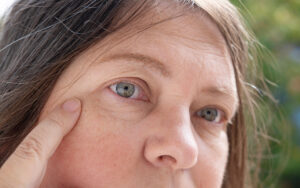Behçet’s Syndrome

Behçet’s Syndrome disease is a multi-systemic autoimmune inflammatory disorder characterized by oral aphthous lesions, genital ulcerations, iridocyclitis with hypopyon, and skin lesions. With or without hypopyon, vitreous, retinitis, occlusive retinal vasculitis, and cystoid macular edema, Behçet’s disease clinically presents as iridocyclitis. The most common form of this is panuveitis, or inflammation of the uvea. The uvea includes the iris, ciliary body, and choroid. The disease is characterized by recurrent inflammatory periods that may result in irreversible damage and significant visual loss. To prevent ocular morbidity, early treatment is required.
Clinical Manifestations of Behçet’s Syndrome
Behçet’s disease has a wide range of clinical manifestations. Ocular involvement is the initial manifestation in less than 20% of the patients. Up to 50- 70% of men and 20-30% of women are affected with ocular manifestations in nearly 50% of the patients suffering with Behçet’s disease.
Within the first 2-4 years of the disease, ocular findings start to manifest. The manifestations are bilateral in 80% of the patients, meaning it occurs in both eyes. The ratio of bilaterality was found 80% among men and 64% among women at the beginning of the disease, according to a study with a large patient group. At the end of a 20-year follow-up, the ratio was found to increase to 87% among men and 71% among women.
Gender Variation of Behçet’s Syndrome
Gender affects the clinical manifestations and prognosis. Younger men with Behçet’s syndrome have a more severe course of symptoms. However, uveitis has a higher frequency in females than in males, particularly in the isolated anterior chamber of the eye. Males have greater visual morbidity because of the higher incidence of vitreous, retinitis, retinal vasculitis, and retinal haemorrhages than females. No consistent inheritance pattern has been confirmed, although several familial cases and a pair of monozygotic twins with Behçet’s disease have been reported. Because uveitis management differs from extraocular involvements with high ocular morbidity, early recognition of ocular involvements is important. The disease still carries a poor visual prognosis despite modern treatment modalities.
Association of Panuveitis with Behçet’s Syndrome
The first ocular symptoms are usually manifested in the patient’s 30’s to 40’s. The primary manifestation can be unilateral in 50-85% of patients and occurs usually as anterior uveitis. In nearly two-thirds of cases, this can change to bilateral panuveitis with chronic relapsing later in life. The diagnosis of ocular Behçet’s disease is based on clinical findings and results are obtained from slit-lamp biomicroscopy and ophthalmoscopy. More in-depth examination includes fluorescein angiography and indocyanine green angiography examinations.
Complications associated with Behçet’s Syndrome
The eye may present with various complications of ocular Behçet’s disease including keratopathy, glaucoma, vitreoretinal hemorrhage, posterior vitreous detachment, macular degeneration, epiretinal membrane, vein occlusion, and phthisis. During acute inflammation, diffuse infiltration of neutrophils and lymphocytes in the iris, ciliary body, posterior synechiae, cyclitic membrane formation, and the thickening of the choroid can be observed.
Histopathologically, infiltration of leukocytes and plasma cells in and around blood vessels in retinal tissue may appear. Veins are more affected than arteries. During inflammation, retinal vascular endothelial cells become swollen. Neutrophil migration and thrombus formation are also observed. In more advanced cases, fibrosis of blood vessels and complete vascular obliteration may be present. Rod and cone cells get destroyed. Fibrosis of the inner nuclear layer appears, however, the destruction of retinal pigment epithelium is minimal. The optic nerve vessels can be affected and can result in optic neuritis, ischemia, and finally optic atrophy. The recurrent attacks of ocular inflammation may result in severe ocular damage. Behçet’s disease may produce permanent vision loss in up to 20% of the affected individuals. The poor long-term visual outcome is usually related to glaucoma and cataract formation.




